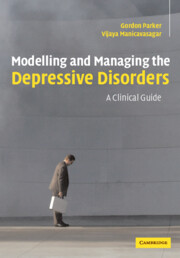Book contents
- Frontmatter
- Contents
- Acknowledgements
- Introduction
- Part I The current model for depressive disorders and its impact on clinical management
- Part II The diagnosis and management of melancholic and psychotic depression
- Part III An introduction to non-melancholic depression
- Part IV Modelling and managing the non-melancholic depressive disorders
- 13 Acute stress-related non-melancholic depression
- 14 Acute stress-related non-melancholic depression: ‘key and lock’ model
- 15 Chronic stress-related non-melancholic depression
- 16 The perfectionist personality style and non-melancholic depression
- 17 Irritability and non-melancholic depression
- 18 Anxious worrying and non-melancholic depression
- 19 Social avoidance and non-melancholic depression
- 20 Personal reserve and non-melancholic depression
- 21 Rejection sensitivity and non-melancholic depression
- 22 Self-focused personality style and non-melancholic depression
- 23 Self-criticism and non-melancholic depression
- 24 Natural and alternative treatments for non-melancholic depression
- Appendix 1 The DMI-18 and the DMI-10
- Appendix 2 The CORE system of measuring psychomotor disturbance
- Appendix 3 The temperament and personality measure
- References
- Index
24 - Natural and alternative treatments for non-melancholic depression
from Part IV - Modelling and managing the non-melancholic depressive disorders
Published online by Cambridge University Press: 17 August 2009
- Frontmatter
- Contents
- Acknowledgements
- Introduction
- Part I The current model for depressive disorders and its impact on clinical management
- Part II The diagnosis and management of melancholic and psychotic depression
- Part III An introduction to non-melancholic depression
- Part IV Modelling and managing the non-melancholic depressive disorders
- 13 Acute stress-related non-melancholic depression
- 14 Acute stress-related non-melancholic depression: ‘key and lock’ model
- 15 Chronic stress-related non-melancholic depression
- 16 The perfectionist personality style and non-melancholic depression
- 17 Irritability and non-melancholic depression
- 18 Anxious worrying and non-melancholic depression
- 19 Social avoidance and non-melancholic depression
- 20 Personal reserve and non-melancholic depression
- 21 Rejection sensitivity and non-melancholic depression
- 22 Self-focused personality style and non-melancholic depression
- 23 Self-criticism and non-melancholic depression
- 24 Natural and alternative treatments for non-melancholic depression
- Appendix 1 The DMI-18 and the DMI-10
- Appendix 2 The CORE system of measuring psychomotor disturbance
- Appendix 3 The temperament and personality measure
- References
- Index
Summary
It has been estimated that up to 50% of Australians who suffer from a depressive disorder may seek self-help or non-medical complementary treatments for their condition. The popularity of natural and alternative treatment lies in their easy availability and low cost, positive associations with optimal health, and social acceptability. Other reasons for their popularity may relate to feelings of self-efficacy and self-direction in matters of personal health and well-being.
Natural and alternative treatments are those practices that are not within the range of mainstream acceptable treatments. Research has indicated that these practices may have some efficacy for some presentations of non-melancholic depression, but are unlikely to be of primary benefit to those who suffer from melancholic or psychotic depression or bipolar disorder.
The range of natural and alternate treatments
There are many types of natural and alternate treatments for depressive disorders, some of which are only just beginning to gain credibility among professionals and the mainstream medical establishment. With the exception of a handful of treatments, the clinical efficacy of the vast majority of these treatments has not yet been empirically determined in randomised controlled trials (RCTs). Furthermore, it is only possible to speculate on how personality features in non-melancholic depression may affect the use of natural and alternative treatments, treatment compliance, and clinical efficacy.
- Type
- Chapter
- Information
- Modelling and Managing the Depressive DisordersA Clinical Guide, pp. 212 - 223Publisher: Cambridge University PressPrint publication year: 2005



